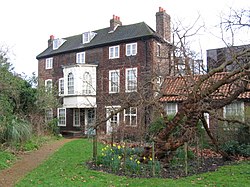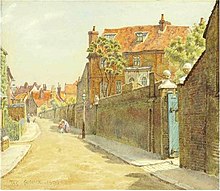Hogarth's House
| Hogarth's House | |
| Middlesex | |
|---|---|
 Hogarth's House | |
| Location | |
| Grid reference: | TQ21257789 |
| Location: | 51°29’13"N, 0°15’18"W |
| Town: | Chiswick |
| History | |
| Built 1713 - 1717 | |
| Information | |
| Owned by: | Local council |
Hogarth's House' is the former country home of the 18th-century artist William Hogarth in Chiswick in Middlesex, adjacent to the A4. The House now belongs to the local council and is opened to visitors as a historic house museum. In the 18th century, Chiswick was a large village or small town quite separate from the metropolis, but within easy reach of it.
The house is a Grade I listed building.[1]
Contents
Construction and early occupation
The house was built between 1713 and 1717 in the corner of an orchard belonging to the Downes family. Its first occupant was Rev George Andreas Ruperti, the pastor of St Mary's Lutheran church in the Savoy, London, who used it as his country home. He cared for the thousands of refugees from the Rhineland who arrived in London following a famine in 1708–9. They hoped to be able to reach America - with Ruperti's help many did, and some settled in the south of Ireland. Ruperti's lists of the refugees, which record their trades, have been invaluable to family historians. He was appointed to the Lutheran Church at St James's Palace in 1728 at a salary of £200 a year. After his death in 1731 his widow retained the House
In 1749, the Hogarth family bought the house from George Ruperti's son.
According to the increased valuations in the parish rate books, the Hogarths extended it in 1750 and Mrs Hogarth added another single storey extension in 1769.[2] It was the artist's country retreat from 1749 until his death in 1764; he had a "painting room" over his coach-house at the bottom of the garden. He shared it with his wife, mother-in-law, his wife's cousin, Mary Lewis (who assisted with his business), and his sister. William Hogarth is buried in the graveyard of the nearby St. Nicholas Church, Chiswick; his fine tomb-monument carries an obituary by his great friend, the actor David Garrick.[3][4] The family's connections with the house continued until Mary Lewis' death in 1808.
From 1814 to 1833 the house belonged to Rev Henry Francis Cary, a poet and skilful translator of Dante's Divine Comedy. He came to Chiswick as Curate of St Nicholas' Church and went on to become Assistant Librarian at the British Museum. He was part of a circle of writers and poets, including Samuel Taylor Coleridge, who promoted Cary's Dante translation and made it a best seller. The House was acquired in 1833 by the Wickstead family; they migrated to Australia in 1840 and left the house to tenants.
Restoration and museum
Alfred Dawson, whose family home at The Cedars adjoined Hogarth's and whose printing works was nearby, rescued the House in 1890 and restored it. He leased it to a nursery gardener along with part of his own garden. However, he sold it in 1900 and it was put up for auction for re-development in 1901. A campaign by artists and writers failed to raise sufficient funds to buy the House but it was purchased by Lieutenant-Colonel Robert William Shipway of Grove House, Chiswick. He restored it with the help of the architect Frederick William Peel and Henry Austin Dobson, Hogarth's biographer. He provided a collection of Hogarth's works, commissioned replica furniture based on pieces in Hogarth prints and even took the photographs for the first guide book himself. He opened it to visitors in 1904. Shipway gave the house to Middlesex County Council in 1909.
In September 1940, during Second World War, the house was damaged as a result of a parachute mine explosion nearby. It was repaired and re-opened in 1951. At that time the single-storey extension was completely rebuilt to provide a small exhibition room. The interior of the House was refurbished for the Hogarth Tercentenary in 1997.
In 2014 the William Hogarth Trust commissioned a special exhibition to be held at the museum to mark the 250th anniversary of Hogarth's death. This exhibition featured artwork submissions from over fifty artists and celebrities in tribute to Hogarth including works by Quentin Blake, Harry Hill, Jacqueline Wilson, Cath Kidston, Peter Blake and Joanna Lumley.
Refurbishment
The house closed for refurbishment in September 2008.[5] On 14 August 2009, there was a fire in the house, which was empty. No furnishings or prints were lost, but the staircase and one room were badly damaged and other areas suffered from smoke damage and the effects of the water which doused the flames. The entire structure was carefully restored and a major research project carried out on the history of the House and its occupants. A paint analysis informed the re-decoration, and original features were repaired and revealed, including window shutters, fire surrounds and hearths, and two areas of original floorboards.
The museum was officially re-opened on 8 November 2011. Two floors of the house are open to visitors and the top floor houses a study/research room for use by appointment. The furnishing includes Shipway's replica pieces and new displays presents the House as a home, as well as celebrating Hogarth's life and work. Prints of some of his best known engravings are on display, including the series A Harlot's Progress, A Rake's Progress and Marriage à-la-mode.
The House has an attractive walled garden which contains a mulberry tree. This is probably the last survivor of the original orchard established in the 1670s. It was damaged by the parachute mine and brought back to good health by arboriculturists from Kew Gardens.
Outside links
- Hogarth's House
- williamhogarthtrust.org.uk
- Images of Hogarth's House at the Country Life Picture Library
References
- ↑ National Heritage List 1358340: Hogarths House, Wall and Gate of Hogarths House (Grade I listing)
- ↑ A History of the County of Middlesex - Volume 7 pp 54-68: Chiswick: Growth (Victoria County History)
- ↑ "The Churchyard". St Nicholas Church, Chiswick. http://www.stnicholaschiswick.org/heritage/churchyard/.
- ↑ McDonagh, Melanie (10 October 2019). "Hogarth: Place and Progress review — Sordid, subversive and richly comic". Evening Standard. https://www.standard.co.uk/go/london/arts/hogarth-place-and-progress-review-john-soane-museum-a4258241.html.
- ↑ "Hounslow Matters" May 2009 (Hounslow Council's magazine)
